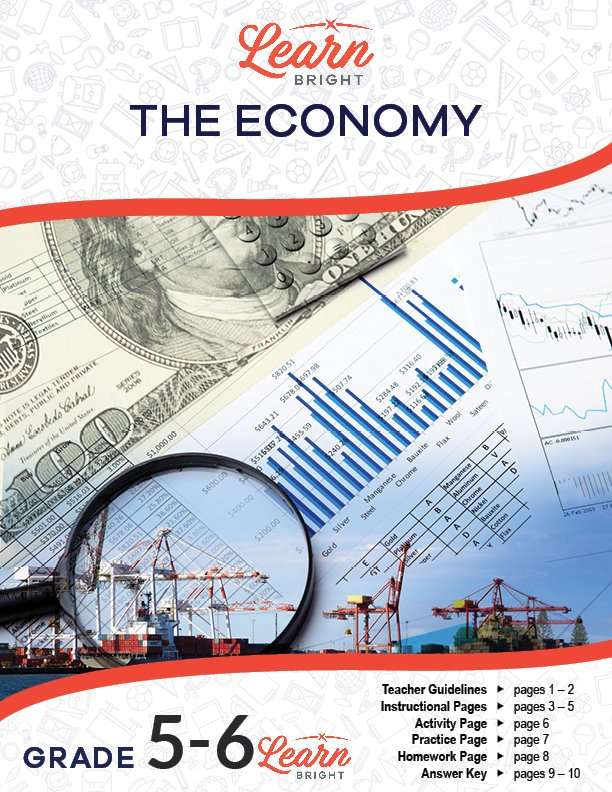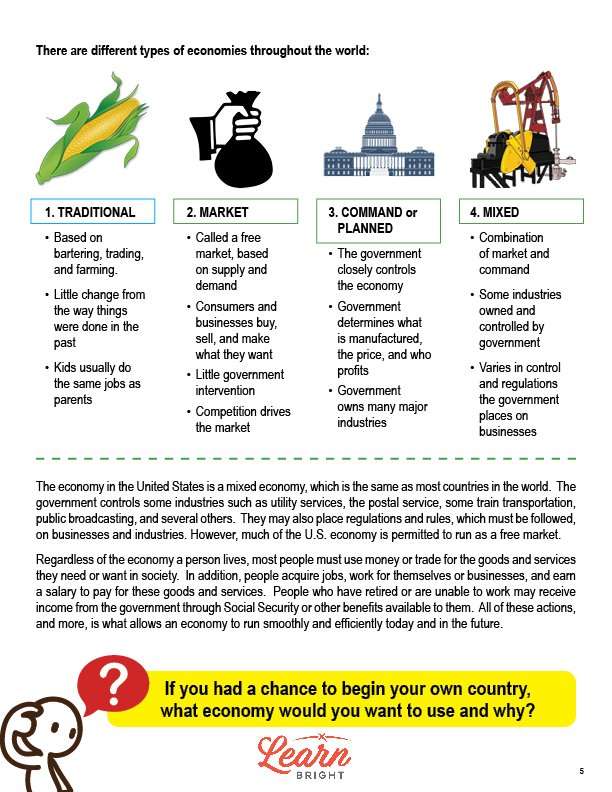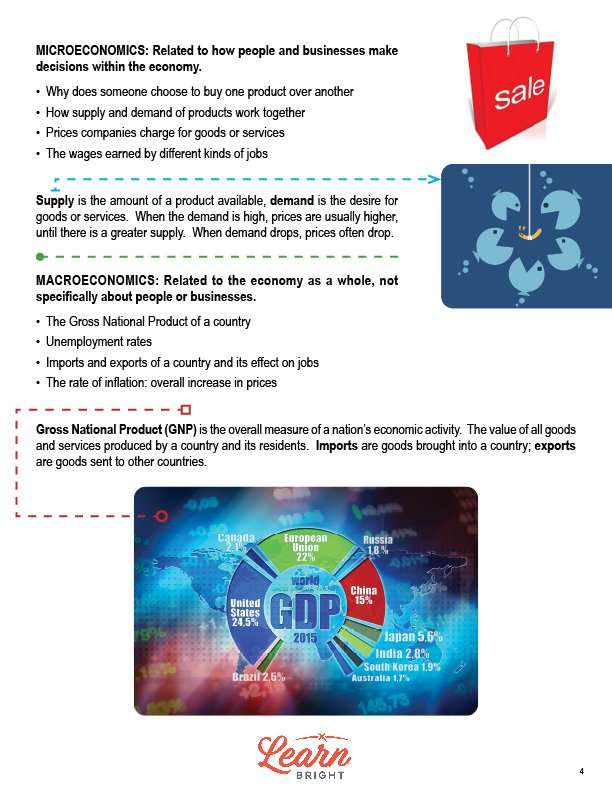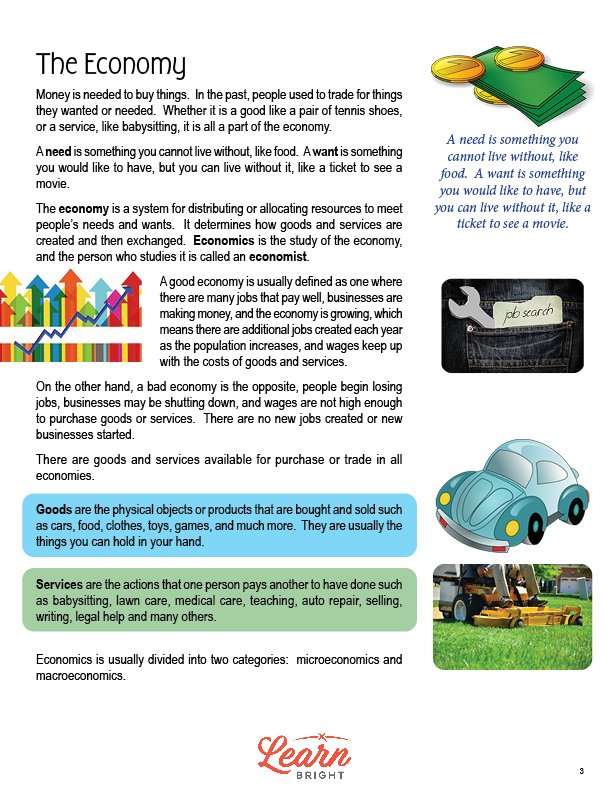Description
What our Economy lesson plan includes
Lesson Objectives and Overview: Economy introduces students to the concept of economics and enables them to understand related concepts and vocabulary. At the end of the lesson, students will be able to define economy, compare and contrast types of economies, and explain the difference between micro- and macroeconomics. This lesson is for students in 5th grade and 6th grade.
Classroom Procedure
Every lesson plan provides you with a classroom procedure page that outlines a step-by-step guide to follow. You do not have to follow the guide exactly. The guide helps you organize the lesson and details when to hand out worksheets. It also lists information in the orange box that you might find useful. You will find the lesson objectives, state standards, and number of class sessions the lesson should take to complete in this area. In addition, it describes the supplies you will need as well as what and how you need to prepare beforehand. The supplies you will need for this lesson are colored pencils, cardboard, scissors, glue, index cards or similar, other supplies for creating a board game, and the handouts.
Options for Lesson
Included with this lesson is an “Options for Lesson” section that lists a number of suggestions for activities to add to the lesson or substitutions for the ones already in the lesson. For an additional activity, you can have students research each of the four economies, finding societies or countries who have used that type of economy currently or in the past. Another idea is to pair students and have them set up an imaginary economy with rules and regulations that citizens and businesses must use and/or must follow.
Teacher Notes
The teacher notes page includes a paragraph with additional guidelines and things to think about as you begin to plan your lesson. This page also includes lines that you can use to add your own notes as you’re preparing for this lesson.
ECONOMY LESSON PLAN CONTENT PAGES
The Economy
The Economy lesson plan includes three content pages. You need money to buy things. Long ago, people traded for the goods (things like tennis shoes) and services (like babysitting) they needed. These are all part of the economy.
Needs are things you can’t live without, like food. Wants are things you’d like to have but can live without, like tickets to a movie. We call the system for distributing or allocating resources to satisfy people’s wants and needs the economy. The study of the economy is economics, and the people who study it are economists.
Good economies have plenty of jobs that pay well, businesses that make money, and a growing economy. Growing economies add jobs every year as the population grows, and has wages that grow to match the rising costs of goods and services.
In a bad economy, people lose their jobs, businesses close, and wages don’t grow to allow people to purchase goods and services. Businesses don’t create new jobs and people don’t start new businesses. People can buy or trade goods and services in all economies.
A good is a physical object or product that people buy and sell, like cars, food, clothes, toys, games, and more. You can usually hold them in your hand.
A service is an action that someone pays someone else to do, like babysitting, lawn care, medical care, teaching, auto repair, selling, writing, legal help, and more.
Microeconomics and Macroeconomics
We usually divide economics into two categories: microeconomics and macroeconomics.
Microeconomics relates to how people and businesses make decisions within the economy. They try to figure out why someone chooses to buy one product over another one, how supply and demands works, the prices companies charge for goods and services, and what wages people earn in different kinds of jobs.
Supply refers to the amount of a product available, and demand refers to the desire for goods or services. When demand is high, prices trend higher. When demand is low, prices trend lower.
Macroeconomics relates to the economy as a whole, not specifically about people or businesses. They include the Gross National Product of countries, unemployment rates, countries’ imports and exports and their effect on jobs, and the rate of inflation (an overall increase in prices).
Gross National Product (GNP) refers to the overall measure of a nation’s economic activity. It is the value of all goods and services produced by a country and the people who live there. Imports are goods that a country brings in. Exports are goods that a country sends to other countries.
Types of Economies
People base traditional economies on bartering, trading, and farming. Things don’t change that much from the way people did them in the past. Kids usually do the same jobs as their parents.
We call market economies a free market, and they rely on supply and demand. Consumers and businesses buy, sell, and make whatever they want. The government intervenes rarely, and competition drives the market.
In command or planned economies, the government closely controls the economy. The government decides what people manufacture, the price, and who will profit. The government also owns many of the major industries.
Mixed economies are combinations of market and command. The government owns and controls some industries. The government places a variety of controls and regulations on businesses.
The United States has a mixed economy like most of the countries in the world. The government controls some industries, like utility services, the postal service, some train transportation, public broadcasting, and more. They can also create regulations and rules that businesses and industries must follow. Most of the U.S. economy can run as a free market.
Most people in the world use money or trade for goods and services, regardless of the type of economy they live in. People get jobs, work for either themselves or a business, and earn salaries to pay for goods and services. People can receive income from the government if they retire or cannot work through Social Security or other benefits. Economies run smoothly today and in the future because of all of these actions.
ECONOMY LESSON PLAN WORKSHEETS
The Economy lesson plan includes three worksheets: an activity worksheet, a practice worksheet, and a homework assignment. You can refer to the guide on the classroom procedure page to determine when to hand out each worksheet.
BOARD GAME ACTIVITY WORKSHEET
Students will work with a partner to complete the lesson activity. Each pair will create a board game, using the game Monopoly and the economies they’ve learned about as inspirations. The game must be for two or more players and each pair must create their own instructions, board, and other components. Once complete, students will swap their game with another pair’s and they will play each other’s games.
ECONOMY TYPES PRACTICE WORKSHEET
The practice worksheet asks students to write the correct type of economy (traditional, market, command, or mixed) for each description on the worksheet. They will also determine whether different things are part of microeconomics or macroeconomics.
ECONOMY HOMEWORK ASSIGNMENT
For the homework assignment, students will first match terms with their definitions. They will then list five needs they may have, five wants they may have, five goods in an economy, and five services of an economy.
Worksheet Answer Keys
This lesson plan includes answer keys for the practice worksheet and the homework assignment. If you choose to administer the lesson pages to your students via PDF, you will need to save a new file that omits these pages. Otherwise, you can simply print out the applicable pages and keep these as reference for yourself when grading assignments.









